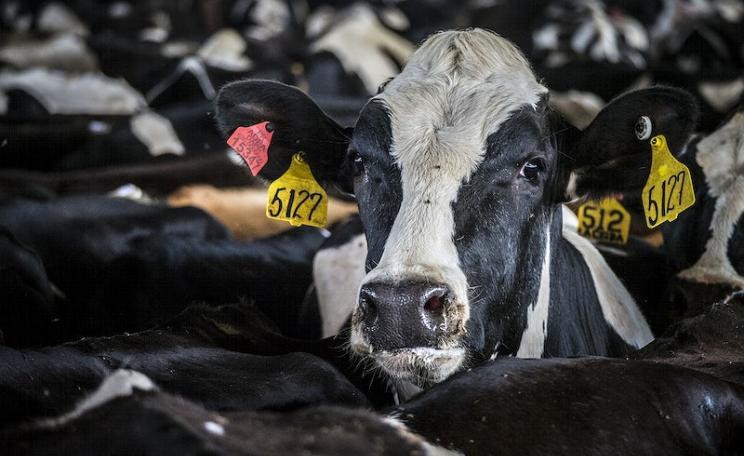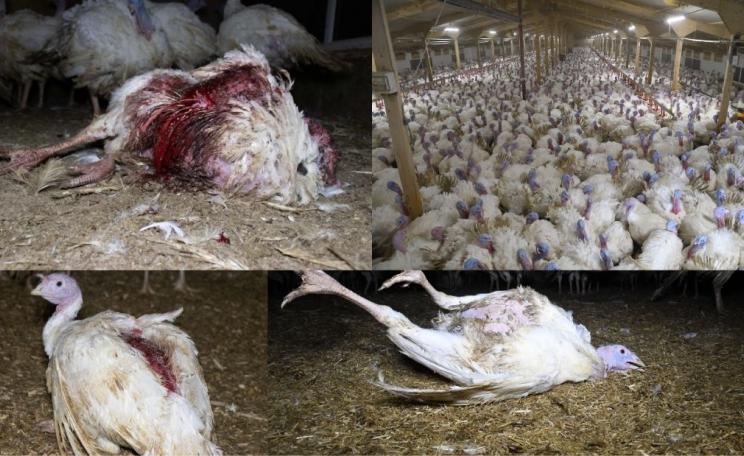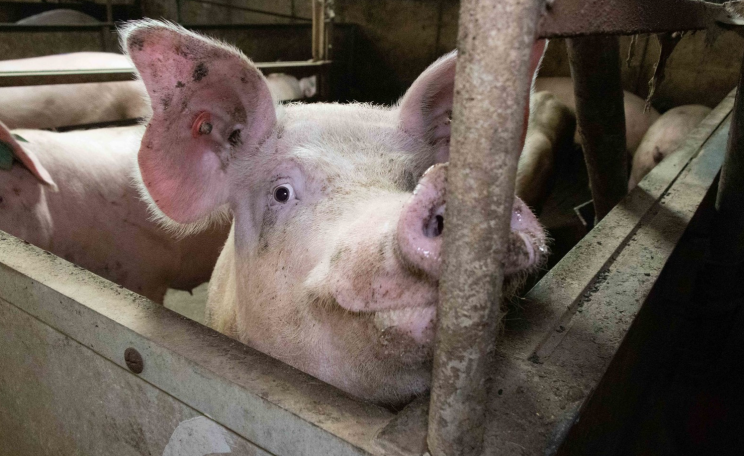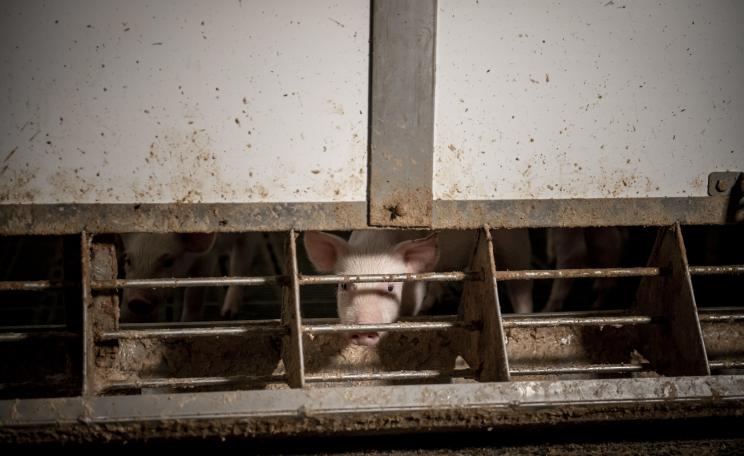What this first finding proves to me is that vegan food can provide protein without being unhealthy.
The cost of living crisis is really starting to bite: in the UK we may be heading towards a winter of no heating and no eating. There are thousands of families who are already there. Vegan food often costs more than food based on animal products, so will people have to resort to eating meat to get through this economic crisis?
The British Retail Consortium warned yesterday that food inflation across the UK reached 9.3 percent in August – the highest inflation rate since the global economic crisis of 2008. The price increases for fresh foods are even worse, reaching 10.5 percent. “Ambient food” such as tinned beans and dried pasta also increased in price, to 7.8 percent.
Read the British Retail Consortium report.
Vegan diets have often been criticised as being more expensive than meat-based or vegetarian diets: as a luxury only available to the middle class and those living in highly industrialised countries.
Cheapest
Families are already facing a staggering 18 percent increase in inflation across the board next year. So is it possible to live on a healthy, balanced vegan diet when a weekly shop that costs £100 will all of a sudden cost £110 – or even more?
The other major concern with veganism is that people might not get the nutrients they need. I recently discovered that I was not eating enough protein, an essential part of the diet that supports good physical and mental health.
Protein is often the most expensive kind of food, with sugar and fats dominating cheaper supermarket options. So how can we ensure we get enough vegan protein without breaking the bank? I deployed my decades of journalism experience to find out.
My investigation was not undercover. It did not take me to strange and wonderful places. I was cat-sitting for a friend in the seaside town of Bournemouth, Dorset.
So I simply visited the local Co-op with a very specific question: where can I get cheap protein that is not milk, fish or meat? This I broke down into three further queries: 1. What is the cheapest protein? 2. What is high in protein but low in calories? and 3. What are the cheapest calories I can buy?
Superfood
The methodology is really simple. Food today comes with nutritional information, and obviously everything comes at a price. I simply had to do a quick shop, get the stuff home, and then do some basic maths – or, more accurately, type some formulas into a spreadsheet. I also photographed some packs of milk, chicken and pork so that I could get the information I needed without breaking my ‘mostly vegan’ rule.
I did specifically seek out higher-protein vegan foods during the shop. The aim was to find out whether this was possible and not to create some kind of scientific study about whether vegan food in general has as much protein as meat.
What this first finding proves to me is that vegan food can provide protein without being unhealthy.
Note that when I say ‘calorie’ I am referring to the kilocalorie (kcal) of the product, which is actually 1,000 calories of energy but is commonly referred to as ‘calories’. I have rounded the figures for ease of comparison.
My results were broadly reassuring. It is very possible to buy vegan food that is at least as rich in protein as animal products – and often cheaper. What I found surprising and very welcome was that basic vegan foods performed as well as the fancy new meat substitutes that have started to dominate our section of supermarket shelves.
I also found that the Huel powder I buy (see below) – the Black Edition Chocolate Flavour – is no more expensive than regular food when looking at the protein you get, while the protein-to-calorie ratio was in a different league. But if you really want a superfood, you should rely on the thing that vegans have been saying since the term ‘vegan’ was first invented: lentils are great.
Stocked
The Dried Red Split Lentils from the local Co-op proved to be the cheapest form of protein-rich food that I found in my everyday shop. By my calculations, you get 69 grams of protein for every £1 you spend.
The closest runner-up was again a basic, old-fashioned vegan food. Whole Earth’s Crunchy Organic Peanut Butter packs 26 grams of protein into every £1. In terms of vegan food, Batchelor’s Original Mushy Peas and Heinz Beanz came next, with 22 grams.
Vegans who know what they are doing will not be surprised that lentils, peas and peanuts are so rich in protein. They are all legumes. Legumes also include chickpeas, soybeans and the beans used in baked beans. I now remember people saying that as a vegan I should eat lots of legumes, but as there is no section of that name at the supermarket, I guess that advice seemed too abstract for my harried mind.
The one product I have included in this short survey despite not buying it locally is Huel, a relatively new “nutritionally complete powdered food”. Huel is stocked as a drink in the Co-op, but I buy it in powder form direct from the company, delivered in two cumbersome, expensive, 1.5kg packets. I have it for breakfast. What this research has shown me is that when buying for protein, Huel is actually cheaper than pork, chicken and fish – at 21 grams for a quid.
The league of high-protein-and-low-cost foods is then dominated by animals. I found that Co-op- branded Organic Fresh Semi-skimmed Milk contains 24 grams of protein for each £1 of product. The Co-op’s British Chicken Breast Fillets provide 21 grams, and Mackerel Fillets in Tomato Sauce (tinned) have 18 grams, while Richmond Thick Pork Sausages give you 16 grams. Fresh fish – in this case the Co-op’s farmed Salmon Fillets – is more expensive, with less than nine grams.
Supermarkets
This makes no sense, because animals eat far more protein – very often legumes – than they produce in meat. This use of natural resources should be reflected in the price.
But the cost of making animal protein has been massively reduced by cruel factory farming, misplaced subsidies and economies of scale. If anyone reading this believes in the free market, you need to start lobbying for the massive government support for the meat industry to stop now.
What was still surprising to me, though, was that meat did not massively outperform vegan foods when it came to the cost of eating protein. Bog standard Co-op Easy Cook Long Grain Brown Rice packed 16 grams of protein into £1 of produce. This is very nearly the same as Richmond Thick Pork Sausages. When you think protein, do you think rice? I certainly didn’t. Chickpeas are also great – coming in at just under 16 grams.
Tofu, the thing vegans are constantly being told to eat for protein, will get you 15 grams of protein for £1 spent on the basic product from The Tofoo Co. Then we have less packed but still worth buying products such as Co-op Houmous, at eight grams; Co-op Closed Cup Mushrooms will get you less than three grams of protein per £1.
There are also the more recent, more processed vegan products that have been specially formulated to have high protein content. These have been manufactured to taste and look like meat. They are being placed by supermarkets next to beefburgers and pork sausages more often these days. These products are a good choice for vegans but also appeal to meat eaters who don’t want high-fat, high-calorie products in their or their children’s meals.
Protein
The products stocked by the Co-op in Bournemouth include The Incredible Burger, which has 15 grams of protein in every £1 of spend; Better Naked Evolution Burgers, which come pretty close with 11 grams, and Alpro’s Plain Yoghurt Alternative, which will give you precisely 10 grams of protein for the same money.
Surprisingly, Quorn Vegan Smoky Ham Free Slices have less than six grams of protein for every £1 you have to spend, according to my figures. Quorn was meant to be a scientific breakthrough, creating a whole new protein from fungus. But as we can see, when it comes to how much Quorn products will cost you at the till, they are only just a bit more than twice as protein-filled as your ‘common or garden’ mushroom.
For a vegan diet to be healthy it needs to have enough protein – but not too much fat and sugar. Protein makes calories, and excess protein is converted by our bodies into sugar and stored as fat. The problem is that cheaper foods often include some protein but much more fat and carbohydrates (starch and sugar). Increasing protein in the diet can thus also mean increasing calories to an unhealthy level.
The Harvard University School of Public Health discusses the fact that foods eaten for protein always contain other things – including fat in varying amounts. Its experts advise that the nature of this “protein package” determines your health outcome. It is also worth noting that in the United States and other heavily industrialised countries, most people eat too much meat – and therefore actually eat too much protein.
The leading item for high-protein and lower-calorie meals in my study is Co-op British Chicken Breast Fillets, which I calculate provide 0.23 grams of protein for every calorie. This is followed by Quorn Vegan Smoky Ham Free Slices, with 0.14 grams of protein per calorie but less than half the calories.
Ratios
After that comes the mighty mushroom, with 0.13 grams of protein per calorie. The next three items on my list are all vegan: Naked Vegan Tofu from The Tofoo Co., at 0.1 grams, and then black-label Huel and Heinz Beanz, both slightly lower but rounding to 0.1 grams.
What this first finding proves to me is that vegan food can provide protein without being unhealthy. This is true of old-fashioned legumes and the other vegetables, as well as the more processed recent vegan alternatives.
I found that fresh salmon fillets have 0.08 grams of protein per calorie, with the mackerel almost identical despite being tinned. Alpro’s Plain Yoghurt Alternative and Better Naked’s Evolution Burgers – more recent additions to vegan choices – come next with just under 0.08 grams.
This is higher than both the semi-skimmed milk (0.07 grams) and the pork sausages (0.05 grams), which are surprisingly low down in our league table. Rice, houmous and gluten-free bread come last. The fact that the league table ends with gluten-free bread should not be a surprise, as gluten is a protein.
The differences between these products are small. The real lesson here is that old-fashioned vegan choices can have high protein-to-calorie ratios – better indeed than meat. And this has always been the case.
Organic
The severity of the cost of living crisis will mean that many parents will be focused on just making sure their children get enough calories, or at least as many as the family can afford. Avoiding fat and sugar might be a luxury for the wealthy 10 percent of the UK population who are not facing fuel poverty in the coming months.
Vegan food can buy you some calories at a low cost. Interestingly, lentils again perform very well. Indeed, for £1 you are buying 971 calories. It seems therefore that lentils remain the cheapest, most protein-rich and healthiest food that I could find during a run around the nearest supermarket.
Vegan foods – both old and newfangled – work out cheaper for calories than animal products. Brown rice provides 631 calories for £1. Crunchy peanut butter – something most children already like – gets you 562 calories. So the jar might be expensive, but it is value for money.
Likewise, that tin of mushy peas gets you 326 calories and the Co-op Chick Peas in Water get you 316 calories per £1. Of the more ‘invented’ vegan foods, the Huel powder delivers 209 calories for the same money, The Incredible Burger has 207 calories, Evolution Burgers have 148 calories and the Quorn slices have 42 calories.
How does this compare with meat and animal products? Well, organic semi-skimmed milk came fifth on my list, at 344 calories for every £1 spent. We can assume that “full fat” milk would have more calories, and that non-organic milk would be cheaper. The pork sausages came next, with 328 calories for a quid.
Anarchic
There are a good few vegan choices on the list before you come to the next item – the Mackerel Fillets in Tomato Sauce offer 210 calories. This is just above Huel. The fancier, less fatty meats – salmon and chicken breast – only delivered 104 and 91 calories respectively per £1 spent. Vegan food is cheaper per calorie than the higher end of the meat market.
The findings of this small study are clear. There is no need to abandon a vegan diet as a result of the cost of living crisis. Some might find they need to give up the healthier meat options because of the increase in prices, and would be well advised to head for high-protein vegan options rather than cheap fillers.
As a final methodological note it is worth saying that there are different kinds of protein, with different kinds of amino acid. The body requires more than 20 different amino acids and is able to manufacture 13 of these, requiring us to obtain the rest from our diet. This small survey does not look at the kinds of protein in the products – indeed, this information is not available on food labels in the UK.
Vegans can be assured that quinoa, soya, buckwheat and many other products are complete in terms of protein, but they might want to research further to ensure they are not lacking specific nutrients in their diet. But more importantly, vegans need to find ways beyond their food choices in which they can create a world that is habitable for humans and other animals alike.
But in any case, individual shopping choices will not get us and our families out of this crisis. The causes of the increase in prices are the war in Ukraine and the end of cheap Russian fossil fuel supplies; the gouging and price hikes from major oil companies and other industries; the damage to crops and supply chains from climate breakdown. And the root cause of all these problems is capitalism: an anarchic system seeking profit with almost no concern about the actual welfare and nutrition of the world population.
How to calculate the cost of protein and calories in your foods.
Calorie per £1:
Number of calories per 100g divided by 100 = Number of calories per gram
Number of calories per gram multiplied by grams in a pack = number of calories in a pack
Number of calories per pack divided by the cost of the pack in pence = calories per penny
Calories per penny multiplied by 100 = calories per £1
Protein per £1:
Protein per 100g divided by 100 = protein per gram
Protein per gram multiplied by grams per pack = protein per pack
Protein per pack divided by the cost of the pack in pence = protein per penny
Protein per penny multiplied by 100 = protein per £1
Protein per calorie:
Protein per 100 grams divided by the number of calories per 100 grams
This Author
Brendan Montague is editor of The Ecologist. This article was fact checked by Helen Banks.







